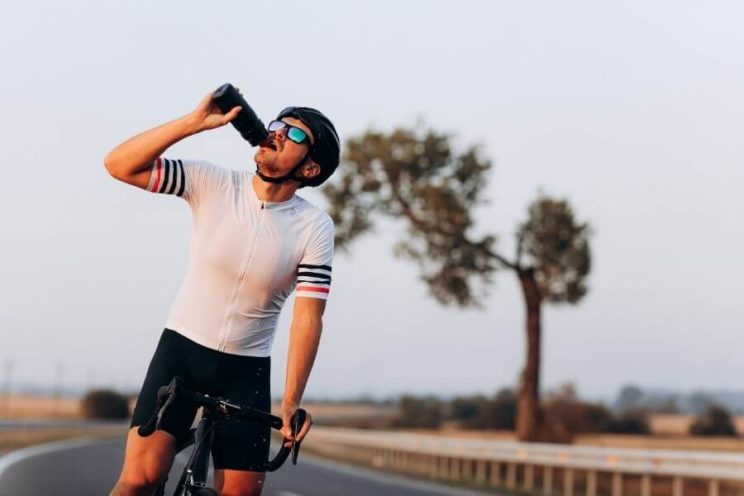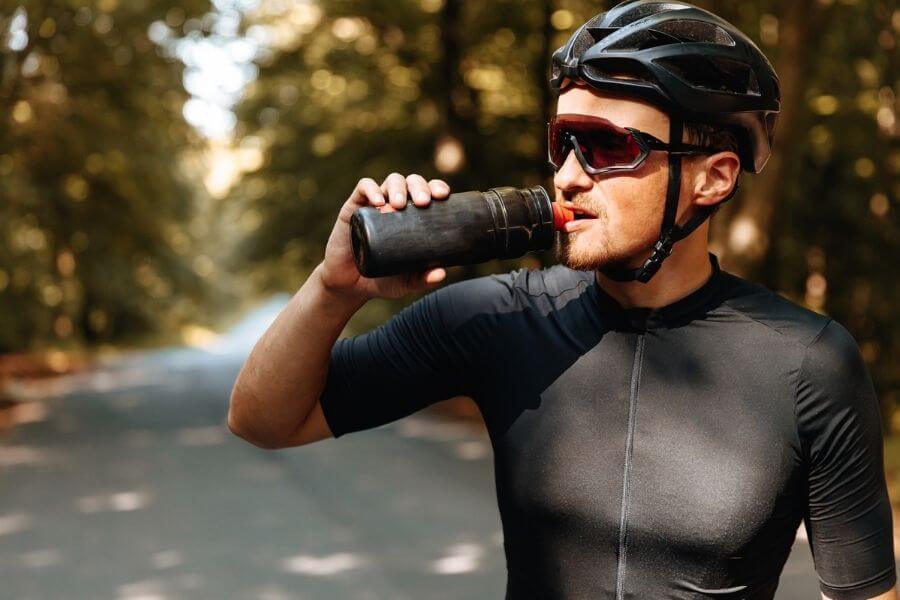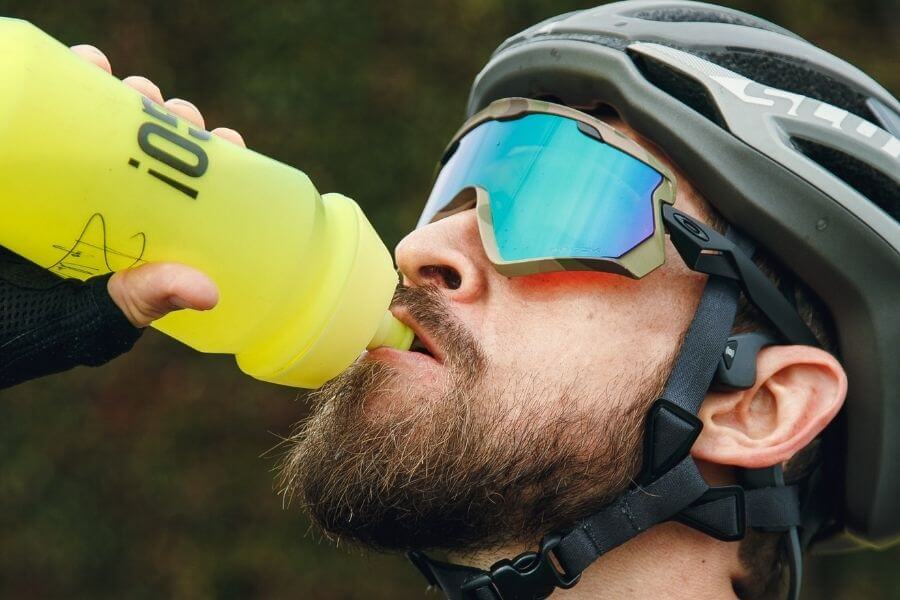Hydrate correctly While practicing cycling is basic for training with guarantees and to avoid physical problems. Especially, when heat squeezes. You know, between 50% and 80% of our body is water, depending on the age and constitution of each person. Maintaining these levels is critical.
Genetics, physical condition, environmental temperature and humidity, and heat conditioning, are factors that determine the speed with which your body can present symptoms of
Dehydration. But the truth is that, if you don't watch this matter, it will end up trapping, yes or yes.
Bad customs such as not carrying enough water, or not drinking frequently during a route, will reduce your performance. With dehydration, you will abandon your strength, you could suffer a faint, dizziness or even a heat stroke.
Nor do you panic and take extreme measures. Drinking liquid can take you to the
overhydration, and its consequences are also harmful to your body.

As they say, virtue is there. Also in relation to cycling hydration. Preview the amount of water we will carry, and organize its intakes, will allow your performance not to be altered.
How many water drums must be carried on the bike for a route in summer? How often do you have to drink? How much in each drink? Is it better to wear isotonic water or drink? Here we explain what guidelines you should follow to
hydrate correctly before, during and after of the output by bicycle.
The muscles responsible for any movement such as pedaling need large amounts of water to move correctly.
Water function in the body
To find answers it is important to underline the importance of water in the organism, even more for a cyclist. It is the element that the human body needs to perform basic functions, such as cell reactions, substance transport or thermoregulation.
Thermoregulation It allows the body to maintain a stable interior temperature that facilitates normal functioning of all its organs. Also that the musculature works properly.
The muscles responsible for any movement, including pedaling, need large amounts of water to work properly. The problem is that the body lacks great capacity for provision and storage. That is why it is necessary to replace the water frequently.
According to the
British Cycling Federation, a moderate or intense exercise session such as cycling eliminates 2% of the agency's water reserve. For example, an 80 kg man would lose 1.6 kg, approximately.
Not replenishing those liquid reserves in time can fold that loss in a short period of time, reducing the work capacity of the muscles, thus appearing
Fatigue and fatigue.
The majority of sports nutritionists agree that when you have to drink is during the
30 or 45 minutes later At the end of training.
How to Hydrate Before Bicycle

But not only have these water reserves replenish while we do the training.
Out of the bicycle You also have to follow hydration patterns that prepare your body for the effort of a training or career.
It is advisable that, days and hours before training or career, you drink water regularly, even without waiting to be thirsty.
In addition, water intake must be accompanied by an input from essential minerals that will protect your discomfort muscles and improve blood circulation. These essential minerals are:
-
Calcium: abounds in dairy, fruits, vegetables and cereals and improves fluidity in nerve impulses and muscle contractions.
-
Iron: Iron -rich foods are legumes, vegetables and meats. They must be part of the diet of a cyclist for being the engine of red blood cells, those responsible for the transport of oxygen to muscle cells.
-
Magnesium: It is counterweight to calcium and phosphorus, which provide energy. It absorbs both and contributes to the recovery and improvement of intestinal transit.
-
Sodium: One of the essential minerals that must be part of efficient hydration. We find it in any salty food and in isotonic drinks. It delays water loss and participates in muscle contractions.
Programming the fluid intakes every 10 or 15 minutes when you go by bicycle is ideal to maintain a correct hydration.
In addition to combining the usual intake of water with a varied diet in these minerals, most sports nutrition experts recommend examining
Urine color, as the best thermometer of efficient hydration. If the color of this is transparent or very clear yellow, it will mean that you are doing a good job.
How to hydrate during the route
Although each person has a different physiology and will need to drink more or less during exercise, the general norm is that you drink
without waiting to be thirsty.
Program fluid intakes
Every 10 or 15 minutes It is ideal to maintain proper hydration. This time interval will also vary depending on our level, duration of the output, difficulty and external temperature.
It is so important to drink during exercise as later, especially for proper muscle recovery.
In summer, water intakes or isotonic liquids (water mixture and mineral salts) must be more frequent; at least,
every 15 minutes. In winter, on the other hand, the interval can increase to 20 minutes.
Many experts recommend drinking
500 ml of water (A small drum) per hour, separating it in different intakes and accompanying it, before training, with a hot drink like coffee or green tea. These drinks fulfill their function of
stimulants to activate the muscles and delay the appearance of fatigue.
For short outputs, water may be enough. Above 60 minutes of effort, the thing changes. When you sweat,
You lose minerals (also called
electrolytes) That your body needs to continue working. In this case, make sure your moisturizing drink contains electrolytes; mostly,
sodium.
Have you ever noticed those white spots on the clothes and in the helmet straps after a suffocating route? It is the salt that we lose, and that we must replace immediately. Low sodium levels are usually associated with the appearance of
cramps
Isotonic drinks have a concentration of sugar that coincides with the concentration of blood sugar (between 6% and 8%). This means that
They absorb quickly. They are an excellent option for bicycle hydration when you also need a small
Chute of
calories.
Be careful with other types of drinks, such as
energy drinks and carbonated drinks. They contain a lot of caffeine and sugar. Its pleasant taste leads us to consume them too much
happiness. But excessive consumption causes more damage than benefit.
Caffeine makes you sweat faster and urinate more frequently. It also stimulates intestinal movement, which makes you lose water and easily enter into
dehydration risk. Health experts do not recommend them during your bike routes, much less on hot days.
On the other hand, keep in mind that in summer the water does not take long to heat up. There is no more unpleasant than a good sip of
hot broth more than 30 degrees. Therefore, buy some
Bidon with thermal insulation guy
Camelbak It is always a good idea. They are not infallible, but they maintain the temperature for a longer time.
As an alternative, there are some
Homemade tricks. The one that works best for us: Fill three quarters of the drums with water, put them in the freezer the night before the route and fill with water to the top just before leaving with the bike. Easy and effective.
How to hydrate after each output or bicycle route
After finishing training or bicycle race, the hydration process must continue. It is so important is drinking during exercise as later, especially if we talk in terms of
Muscle recovery.
As a general rule, you should drink enough water to recover your body weight prior to your cycling route. Do not worry if you are in full phase of weight loss, since it is something that will not interfere with your goals.
Almost all the weight you lose when walking by bike is water. On the other hand, almost all the loss of body fat occurs during the 24 hours after the effort, during the recovery process.
The majority of sports nutritionists agrees that during the 30 or 45 minutes after the completion of the training is when you have to drink.
If you want to refine your recovery even more, we recommend that you drink frequently during the period immediately after exercise, which refers to the famous
Metabolic window.
Sports nutritionists advise drinking and eating, especially during
30 or 45 minutes later At the end of training. It is the most appropriate time to replace liquid reserves and accelerate the recovery of muscle fibers.
In this phase of hydration a posteriori, you should combine water with isotonic drinks, or have a shake rich in protein and carbohydrates ready. You can buy it or prepare it with natural ingredients (fruit, cereals, etc.).
It is not recommended, however, drink
Carbonated soft drinks (As we have already mentioned) or
alcoholic beverages Like beer, which will delay the rehydration of the body and are harmful to organs such as the liver or the kidney.
How much water do you have to drink?

In addition to drinking frequently before the route, or schedule the intakes during and after training, you must also attend to the
amount of liquid ingested
It is better to drink little in many intakes than to drink a lot on a few occasions. This will keep liquid reserves more balanced during exercise.
Also, it is better to have a
good water reserve than to carry a fair amount. At any exit, unforeseen events, breakdowns, falls can arise ... In addition, you must count on that the temperature in certain areas can be especially suffocating. In the valleys of the mountains it usually concentrates a lot of heat and moisture in summer, which forces to consume more liquid than the one planned.
In this sense, a good solution is to install a
Extra tabidon On your bike to carry another drum, or carry a hydration backpack, highly recommended for routes of
Mountain Bike. This backpack will also allow you to transport spare parts and food with comfort, in addition to increasing your liquid reserve.
As we said above, many experts recommend ingesting
500 ml of water for every hour of cycling activity, orientatively.
Carrying more water or isotonic drink for longer or intense training does not suppose you have to force you to drink more. It is very important to control the amounts of ingested liquid, since drinking in excess can cause physical problems due to a drop in the blood sodium level, flowing into a
Hyponatremia.
It is rare that it appears (it usually does in very intense tests such as marathons or triathlons) but when it does a serious picture very similar to that of the heat blow, which if it is not treated it can have very serious consequences.
 As they say, virtue is there. Also in relation to cycling hydration. Preview the amount of water we will carry, and organize its intakes, will allow your performance not to be altered.
How many water drums must be carried on the bike for a route in summer? How often do you have to drink? How much in each drink? Is it better to wear isotonic water or drink? Here we explain what guidelines you should follow to hydrate correctly before, during and after of the output by bicycle.
As they say, virtue is there. Also in relation to cycling hydration. Preview the amount of water we will carry, and organize its intakes, will allow your performance not to be altered.
How many water drums must be carried on the bike for a route in summer? How often do you have to drink? How much in each drink? Is it better to wear isotonic water or drink? Here we explain what guidelines you should follow to hydrate correctly before, during and after of the output by bicycle.
 But not only have these water reserves replenish while we do the training. Out of the bicycle You also have to follow hydration patterns that prepare your body for the effort of a training or career.
It is advisable that, days and hours before training or career, you drink water regularly, even without waiting to be thirsty.
In addition, water intake must be accompanied by an input from essential minerals that will protect your discomfort muscles and improve blood circulation. These essential minerals are:
But not only have these water reserves replenish while we do the training. Out of the bicycle You also have to follow hydration patterns that prepare your body for the effort of a training or career.
It is advisable that, days and hours before training or career, you drink water regularly, even without waiting to be thirsty.
In addition, water intake must be accompanied by an input from essential minerals that will protect your discomfort muscles and improve blood circulation. These essential minerals are:
 In addition to drinking frequently before the route, or schedule the intakes during and after training, you must also attend to the amount of liquid ingested
It is better to drink little in many intakes than to drink a lot on a few occasions. This will keep liquid reserves more balanced during exercise.
Also, it is better to have a good water reserve than to carry a fair amount. At any exit, unforeseen events, breakdowns, falls can arise ... In addition, you must count on that the temperature in certain areas can be especially suffocating. In the valleys of the mountains it usually concentrates a lot of heat and moisture in summer, which forces to consume more liquid than the one planned.
In this sense, a good solution is to install a Extra tabidon On your bike to carry another drum, or carry a hydration backpack, highly recommended for routes of Mountain Bike. This backpack will also allow you to transport spare parts and food with comfort, in addition to increasing your liquid reserve.
As we said above, many experts recommend ingesting 500 ml of water for every hour of cycling activity, orientatively.
Carrying more water or isotonic drink for longer or intense training does not suppose you have to force you to drink more. It is very important to control the amounts of ingested liquid, since drinking in excess can cause physical problems due to a drop in the blood sodium level, flowing into a Hyponatremia.
It is rare that it appears (it usually does in very intense tests such as marathons or triathlons) but when it does a serious picture very similar to that of the heat blow, which if it is not treated it can have very serious consequences.
In addition to drinking frequently before the route, or schedule the intakes during and after training, you must also attend to the amount of liquid ingested
It is better to drink little in many intakes than to drink a lot on a few occasions. This will keep liquid reserves more balanced during exercise.
Also, it is better to have a good water reserve than to carry a fair amount. At any exit, unforeseen events, breakdowns, falls can arise ... In addition, you must count on that the temperature in certain areas can be especially suffocating. In the valleys of the mountains it usually concentrates a lot of heat and moisture in summer, which forces to consume more liquid than the one planned.
In this sense, a good solution is to install a Extra tabidon On your bike to carry another drum, or carry a hydration backpack, highly recommended for routes of Mountain Bike. This backpack will also allow you to transport spare parts and food with comfort, in addition to increasing your liquid reserve.
As we said above, many experts recommend ingesting 500 ml of water for every hour of cycling activity, orientatively.
Carrying more water or isotonic drink for longer or intense training does not suppose you have to force you to drink more. It is very important to control the amounts of ingested liquid, since drinking in excess can cause physical problems due to a drop in the blood sodium level, flowing into a Hyponatremia.
It is rare that it appears (it usually does in very intense tests such as marathons or triathlons) but when it does a serious picture very similar to that of the heat blow, which if it is not treated it can have very serious consequences.












